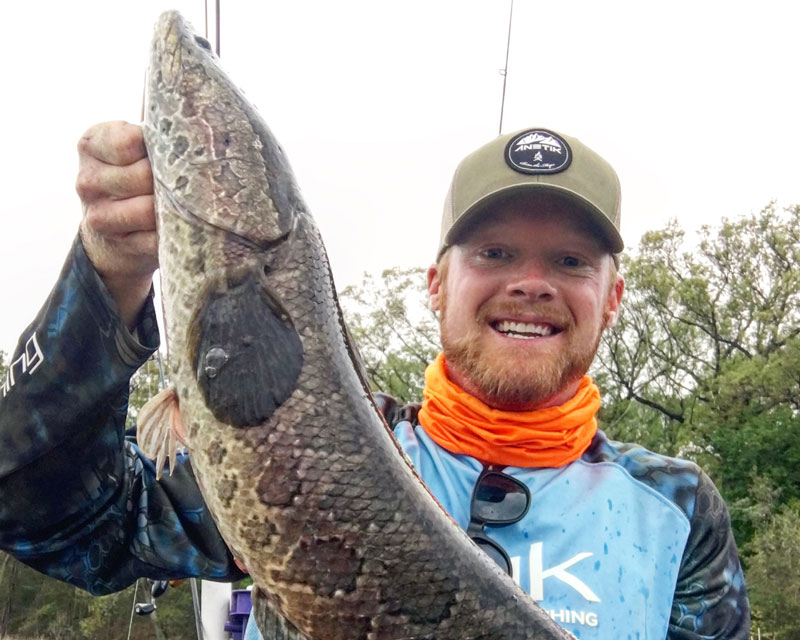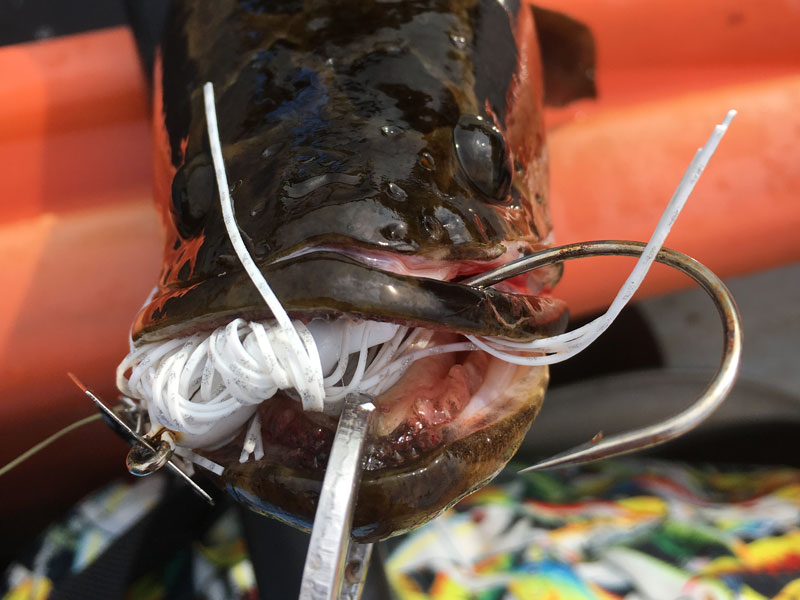The great snakehead debate continues as these invasive but exciting fish multiply in our region and by now, odds are that you have either heard of, hooked, or maybe even landed a few Northern Snakeheads for yourself. These fish are known for explosive topwater blow-ups, chip-on-their-shoulder attitude, and delicious meat. Whether you’re a few months into it or just beginning to buy the hype, these tips and tactics will help you catch more snakeheads in the most exciting way possible: with artificial lures.

Boat Position and Casting for Snakeheads
Finding the waters where these slimy snakes prowl is only part of the battle. If you go to a well-known location and blind-cast to marshy shorelines or spatterdock edges you will probably end up with a few snakes in the boat. However, as with any task it’s always better to work smarter, not harder. To fool those snakeheads, you need to understand them. They love skinny, protected water, no current, and often want some structure at their back. This trait applies to marshy areas common on the Eastern Shore such as the Blackwater, or spatterdock fields which are more prevalent in the Potomac River region. With this behavior in mind, your boat should be positioned to maximize the amount of time your lure is in the skinny water while passing as many nooks and crannies as possible on each cast. To do this, push your boat up against the shoreline and take long casts parallel to it at varying distances from the edge. Start by casting as close as you possibly can to the spatterdock, reeds, or marsh edges. If the snakehead is facing outwards, casting like this means that your lure is in prime territory for the entire retrieve.
If nothing happens initially, continue surgically casting, working further away from the shore. Remember, you don’t always know what the bottom topography looks like, especially in the more tannic waters of the Eastern Shore, so even though a good cast against a prime shoreline might not yield anything at first, there might be a couple of snakeheads sitting in ditches or near submerged logs just feet away from the shore’s visible features. Be methodical, and hit every area from multiple angles and with multiple casts.

Small alcoves are one of the snakehead’s favorite places to hide. Some indents are so small they wouldn’t even warrant a cast when targeting other species. For snakes, these are prime territory. However, don’t forget that as aggressive as these fish are, they can also spook. I’ve ruined many promising opportunities by casting right on top of their hiding places. When using a weedless lure and targeting an alcove, or any tight space, one of my favorite strategies is to cast directly into the reeds or onto the shoreline behind the spot you want to hit. Then, use your rod tip to slowly and gently pull your lure out of cover and into the water. It’s more natural (think of a frog entering from the shoreline) and will usually prevent the snakehead from zipping off into oblivion. Begin your retrieve, and, if you’re using topwater, keep your rod tip pointed up. This is crucial, as it will shrink your chances of getting snagged on vegetation or other structure. After a strike, lowering the rod allows the snakehead the time and line that it needs to fully eat your lure.
The Snake Wake and Hook-sets
Eventually, if they’re in the area and are hungry or annoyed enough, you’re going to experience what for me is the biggest rush in fishing: a snakehead waking your lure. It might start with a swirl or a small wave, but eventually it builds speed, chasing down your lure and preparing to strike. This is where the true challenge begins. As the snakehead approaches your lure, continue your normal speed and retrieval style. That’s what intrigued the snakehead initially, so why change it? Many times this will lead to a strike. However, if the snakehead is waking but hesitant to commit, try a quick pop and pause to trigger an attack.
When you get a blowup, the snakehead’s sucking, smacking, popping sound is unmistakable—and now you’ve got a fight on your hands. The hook needs to be set harder than with any other fish I’ve personally encountered. Snakeheads have relatively small, bony mouths, so not only is there less surface area than, for example, a largemouth bass, but you also need to punch those hooks through. First though, you’ve got to give the snakehead time to eat your lure. Any snakehead angler can probably tell you dozens of stories about setting the hook too early and subsequently having to dodge their lure as it rocketed back towards them at the speed of a Hellfire missile. So bow your rod tip, and begin counting. This will go against every instinct in your body, which will be telling you to match the quick strike of the snakehead with a lightning-fast hookset of your own. But you’ve got to resist.
Make the process methodical: when you get a hit, bow the rod tip from one o’clock down to four or five o’clock and slowly reel in almost all of the slack. While doing this, count to three. That should give the snakehead all the time it needs. When setting the hook, I’ve found that a vertical hookset greatly increases my hookup ratio as opposed to setting it sideways, parallel to the water’s surface. Lean forward, hang on tight, and then send your rod tip flying straight up into the air, and, hopefully, your hook straight into the snakehead’s mouth.

Fighting a Snakehead
If your hookset is successful, the battle is just getting started. The first rule of thumb when you’ve hooked a snakehead is to keep the line tight and the hook pinned. Sometimes when they feel the hook snakeheads will immediately leap into the air at odd angles, making your job much harder. Do your best to ensure that the line stays tight. Many times I’ve netted a snakehead only to see the hook fall out of its mouth, and the only thing keeping that fish on the line was tension and the bear-trap grip of the snakehead’s jaw.
Finish the Fight: Netting a Snakehead
Once you’ve fought the snakehead to your boat, you’ll want to net it. There’s a joke among snakehead anglers which jests that you never truly catch a snakehead until it’s on your dinner plate. A net greatly improves the chances of that happening. Leave enough line out so that you can lead the snake into your net. Next, open your bail and set the rod into a rod holder, freeing up one hand. At this point, I prefer to get my lip grippers into the snake’s mouth. Using your line is a good way to pull its face towards you, and your hooks will sometimes provide enough of a gap to slide the grips in. Then, use pliers to remove the hook. Some anglers like to lift the snakehead into their boat before removing the hooks, but I fish from a kayak and the thought of those teeth and hooks in between my legs is enough to keep me up at night.
Once the hook is removed you can measure, take photos, or dispatch the fish for eating purposes, as you conscience and your taste buds dictate. Now wash the slime off, move a few feet forward, and keep casting!
Fishing Tips for Tricking Snakeheads
- Listen closely. When feeding, the distinct sound of a snakehead will give away its location. Also, look for bubbles.
- If the shoreline bite is poor, find a muddy, shallow flat or cove and toss out a Whopper Plopper size 75 or 90. If it’s windy, do the same using a Chatterbait.
- Don’t lose focus when your lure leaves the strike zone. Sometimes the snakehead won’t hit until it’s near the boat, so you need to stay focused throughout the entire cast.
- Calm, hot weather is a snakehead’s friend. Stick it out through the midday heat!
- Go where others haven’t. There are many well-known locations to catch snakeheads, but these fish are plentiful and spreading quickly. Don’t rule out a spot just because you haven’t heard that it produces. If it’s stagnant, shallow, and connects to a body of water where you know there are already snakeheads, then your chances are good.
- Adjust your strategy. Like any other fish, snakeheads can be fickle, but they can also be patterned, so change up your tactics until you find a strategy that produces.
- If the snakehead misses your topwater lure or you pull the hooks, immediately cast back in with a Chatterbait. This is a highly successful follow-up lure.
- By Matthew Stone
Editor's note: Don't forget, snakeheads are an invasive species and while their harvest is encouraged, transporting them live definitely is not. See the Chesapeake Bay Program Northern Snakehead page, for more information on their presence in the DelMarVa region and Chesapeake tributaries.